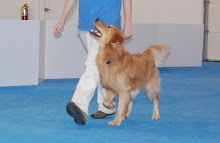What can I see that I really like?
- Position: For the most part, he's parallel and lined up well. His position is fairly consistent.
- Head: I like that he doesn't wrap his head around in front of me. And when I stop he tends to keep his head up, but straight (or nose pointed out), not typically nose pointed towards me.
- Enthusiasm: Consistent throughout. This part of the criteria for our heeling.
What can I see that needs work?
- Starts: I tend to just go and he falls into heeling. We need to work on going from a sit...moving short little bits to reset as we will in the ring between/before exercises.
- Halts: Monitor head position. He didn't do it so well in this instance. Are there other times he does it poorly and I miss?
- Handling: I have been working on this heavily for a few weeks to make my walk more natural and my turns better. I've been practicing with an invisible dog, with a person as the dog role, and with another dog. I fall back into training mode as soon as I have Griffin....and start handling poorly again. I need to make my behavior more fluent!
- Hands: I have to decide to keep my left hand down and moving (and teach Griffin to heel despite the motion) or have my left hand up and teach him to maintain his position despite the hand up.
- About turns: And watch his head. I don't mind little flicks to take in information about the environment, but if he pauses as he looks, it could be enough to get him out of position.




2 comments:
I just love watching heeling! Griffin is doing great and I love his prancing.
I'm debating about going back to hand on my waist with the toller since I just can't seem to keep it moving when under any pressure from a trial or match.
Thanks!
I never think he does much prancing, but looking at the video, he really does prance more than average motion.
Let me know if you find any good articles or discussions about the advantages/disadvantages of arm positions for heeling.
Post a Comment